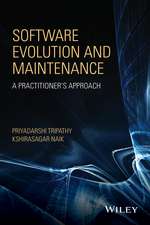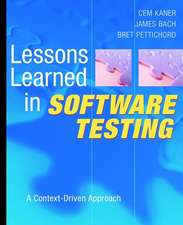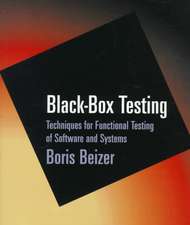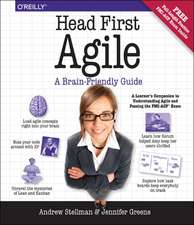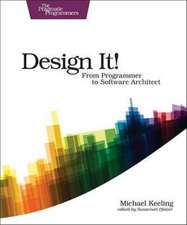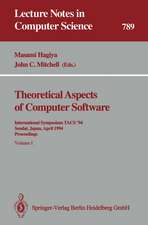Successful Test Management: An Integral Approach
Autor Iris Pinkster, Bob van de Burgt, Dennis Janssen, Erik van Veenendaalen Limba Engleză Hardback – 19 noi 2004
Based on their long-term industry experience, Pinkster and her coauthors describe a holistic approach to test management that combines test methods, test management, risk assessment and stakeholder management into one integral process, giving test managers, test coordinators, IT project managers, and QA managers a competitive edge in environments where there are numerous unstructured requirements, tough testing schedules and limited resources.
This book should be in every test manager's backpack!
| Toate formatele și edițiile | Preț | Express |
|---|---|---|
| Paperback (1) | 365.65 lei 43-57 zile | |
| Springer Berlin, Heidelberg – 30 noi 2010 | 365.65 lei 43-57 zile | |
| Hardback (1) | 342.28 lei 43-57 zile | |
| Springer Berlin, Heidelberg – 19 noi 2004 | 342.28 lei 43-57 zile |
Preț: 342.28 lei
Preț vechi: 427.85 lei
-20% Nou
Puncte Express: 513
Preț estimativ în valută:
65.49€ • 68.57$ • 54.19£
65.49€ • 68.57$ • 54.19£
Carte tipărită la comandă
Livrare economică 07-21 aprilie
Preluare comenzi: 021 569.72.76
Specificații
ISBN-13: 9783540228226
ISBN-10: 3540228225
Pagini: 392
Ilustrații: XVIII, 373 p. 14 illus.
Dimensiuni: 155 x 235 x 26 mm
Greutate: 0.69 kg
Ediția:2004
Editura: Springer Berlin, Heidelberg
Colecția Springer
Locul publicării:Berlin, Heidelberg, Germany
ISBN-10: 3540228225
Pagini: 392
Ilustrații: XVIII, 373 p. 14 illus.
Dimensiuni: 155 x 235 x 26 mm
Greutate: 0.69 kg
Ediția:2004
Editura: Springer Berlin, Heidelberg
Colecția Springer
Locul publicării:Berlin, Heidelberg, Germany
Public țintă
Professional/practitionerCuprins
1 Testing and Test Management.- 2 Risk & Requirement Based Testing.- 3 The Quick Scan.- 4 The Test Management File.- 5 Risk Analysis and Test Strategy.- 6 Estimation.- 7 Planning.- 8 The Test Organisation.- 9 The Dynamics of Testing.- 10 Progress Management.- 11 Issue Management.- 12 Reporting and Advice.- 13 Evaluation and Transfer.- A PRINCE2 and Test Management.- A.1 Similarities Between PRINCE2 and Test Management.- A.2 Position of a Test Project Within a PRINCE2 Project.- A.3 More PRINCE2.- B Checklist of Product Risks.- B.1 Checklist of Product Risks — End Users.- B.2 Checklist of Product Risks — Marketing.- B.3 Checklist of Product Risks — Support Department.- B.4 Checklist of Product Risks — IT Department.- B.5 Checklist of Product Risks — Internal Security.- C Template for Risk- & Requirement-Based Testing.- D Quality Attributes According to ISO9126.- E Template for Test Plan.- E.1 Management Summary.- E.2 Introduction.- E.2.1 Documentation Used.- E.2.2 Standards and Procedures.- E.3 The Test Assignment.- E.3.1 Client.- E.3.2 Supplier.- E.3.3 Goal of the Assignment.- E.3.4 Scope.- E.3.5 Suspension Criteria and Resumption Requirements.- E.3.6 Test Project Deliverables.- E.3.7 Discharging the Test.- E.3.8 Starting Points and Preconditions.- E.3.9 Risks and Risk Countermeasures.- E.4 Test Approach.- E.4.1 Test Strategy.- E.4.2 Preparation.- E.4.3 Analysis.- E.4.4 Test Automation.- E.4.5 Execution and Transfer.- E.5 Planning and Budget.- E.6 Test Organisation.- E.6.1 Stakeholders.- E.6.2 Tasks, Authorities and Responsibilities.- E.6.3 Meetings.- E.6.4 Communication.- E.7 Description of the Test Environment.- E.8 Transfer of Testware to the Organisation.- E.9 Appendices.- F The Goal-Question-Metric (GQM) Method applied to testing.- G Checklist of ProjectRisks.- G.1 Organisation.- G.2 Test Project.- G.3 Test Team.- G.4 The Selected Test Method.- G.5 The Information System.- G.6 Test Environment(s).- G.7 Automated Testing.- H Template for Test Strategy.- H.1 Management Summary.- H.2 Introduction.- H.2.1 Seven Steps.- H.2.2 Documentation Used.- H.3 Stakeholders and Organisational Structure.- H.3.1 Stakeholders of the System.- H.3.2 Organisational structure.- H.4 Link product risks and quality attributes.- H.4.1 Product risk analysis.- H.4.2 Link product risks and quality attributes.- H.5 Test levels and acceptance criteria.- H.5.1 Test levels.- H.5.2 Acceptance criteria.- H.6 Cluster matrix.- H.7 Cluster cards.- I Testing Roles.- J Template for Progress Report.- K Template for Phase Report.- K.1 Management Summary.- K.2 Test Assignment Test Level.- K.3 Quality of the Information System.- K.3.1 Product Risks and Requirements.- K.3.2 Brief Overview of Issues.- K.3.3 Entry and Exit Criteria.- K.4 Planned Versus Realised.- K.4.1 Time.- K.4.2 Money.- K.4.3 Deliverables.- K.5 Recommendations.- L Template for Final Report.- L.1 Management summary.- L.2 Test assignment.- L.3 Quality of the information system.- L.3.1 Product risks and requirements.- L.3.2 Overview of issues.- L.3.3 Acceptance criteria.- L.4 Costs and benefits of the test project.- L.4.1 Costs in time.- L.4.2 Costs in money.- L.4.3 Benefits of the test project.- L.5 Recommendations.
Recenzii
From the reviews:
"While there are many books in the market about testing, there is a paucity of books on the management of this critical area, so the addition of this one is most welcome. The book describes several test strategies, and how these can be leveraged to manage the test process. The general issues with this, and the problems that occur, are described reasonably well, with graphs and charts, which illustrate not only what occurs, but also how and the reasons why. There is also some information about metrics, and how the highly complex test processes occurring today can be measured....no matter how short your short list of management books to read this year is, this ought to be on that list." --ACM Computing Reviews
"There is a prescriptive element in this collaborative book on a test management approach developed … in the Netherlands: ‘Here is The way to do it. Now do it!’… The appendices are very good, and provide helpful checklists. … There is also a clear expression of the roles commonly thought of in testing … . Read this book with a willingness to ask questions, of yourself, your work situation and of the book. … you will find that the questioning pays off." (Software Testing, Verification and Reliability, Vol. 16 (2), 2006)
"While there are many books in the market about testing, there is a paucity of books on the management of this critical area, so the addition of this one is most welcome. The book describes several test strategies, and how these can be leveraged to manage the test process. The general issues with this, and the problems that occur, are described reasonably well, with graphs and charts, which illustrate not only what occurs, but also how and the reasons why. There is also some information about metrics, and how the highly complex test processes occurring today can be measured....no matter how short your short list of management books to read this year is, this ought to be on that list." --ACM Computing Reviews
"There is a prescriptive element in this collaborative book on a test management approach developed … in the Netherlands: ‘Here is The way to do it. Now do it!’… The appendices are very good, and provide helpful checklists. … There is also a clear expression of the roles commonly thought of in testing … . Read this book with a willingness to ask questions, of yourself, your work situation and of the book. … you will find that the questioning pays off." (Software Testing, Verification and Reliability, Vol. 16 (2), 2006)
Notă biografică
Iris Pinkster is test manager at LogicaCMG. She has several years experience in testing and test management in different sectors. She has assisted in the development of the Test management approach as written in this book. She also assisted in the development of TestFrame™, LogicaCMG’s method for structured testing. She is co-author of the TestFrame book, together with Hans Buwalda and Dennis Janssen. Furthermore, she has written a chapter in the Dorothy Graham’s book about test automation. Iris is a trainer of the TestFrame analyse course. She often speaks at (inter) national congresses. Recently she published the book "Succesvol testmanagement: een integrale aanpak" describing LogicaCMG’s Risk & Requirement Based Testing Approach in Dutch.
Bob van de Burgt is test manager at LogicaCMG. He has more than eight years experience in information technology with organizations in the financial sector, trade and industry and public sector. He has cooperated in the development of TestFrame™ test method and the Test management approach of LogicaCMG. Bob also provides test management training and often speaks at (inter) national congresses. Recently he published the book "Succesvol testmanagement: een integrale aanpak" describing LogicaCMG’s Risk & Requirement Based Testing Approach in Dutch.
Dennis Janssen has been working in testing for more than 12 years. During this period he has worked as test consultant helping organizations improving their testprocesses and as a test- and quality manager in many different kinds of projects and companies. Since january 2000, he is manager of the Test Competence Centre (TRC), which is responsible for product development concerning testing within LogicaCMG. Dennis is co-author of the book "Integrated Test Design and Automation, using the TestFrame method" and has several other publications to his name.
Bob van de Burgt is test manager at LogicaCMG. He has more than eight years experience in information technology with organizations in the financial sector, trade and industry and public sector. He has cooperated in the development of TestFrame™ test method and the Test management approach of LogicaCMG. Bob also provides test management training and often speaks at (inter) national congresses. Recently he published the book "Succesvol testmanagement: een integrale aanpak" describing LogicaCMG’s Risk & Requirement Based Testing Approach in Dutch.
Dennis Janssen has been working in testing for more than 12 years. During this period he has worked as test consultant helping organizations improving their testprocesses and as a test- and quality manager in many different kinds of projects and companies. Since january 2000, he is manager of the Test Competence Centre (TRC), which is responsible for product development concerning testing within LogicaCMG. Dennis is co-author of the book "Integrated Test Design and Automation, using the TestFrame method" and has several other publications to his name.
Caracteristici
Describes LogicaCMG’s industry-leading Risk and Requirement Based Testing model in detail Combines traditional test management with project- and product-related risk management Incorporates industry standards like the Goal-Question-Metric method (GQM) and PRINCE2 Offers lots of hands-on advice, helpful checklists and documentation templates Includes supplementary material: sn.pub/extras


